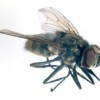Abstract
Horn flies are one of the livestock pests with the greatest impact on the health and productivity of cattle. Economic losses due to horn fly damage are estimated at $36 million annually in Florida alone. In the U.S.A. annual losses total between $700 million and $1 billion, with up to $60 million spent on insecticidal control. Horn fly damage is caused by blood feeding. The flies feed frequently and exclusively on blood, piercing the skin of cattle with their proboscis and taking around 20 small blood meals each day. Pain and irritation due to the constant presence of the flies and their bites causes defensive behavior in the cattle that prevents adequate food consumption and rest. This 4-page fact sheet was written by P. E. Kaufman and E. N. I. Weeks, and published by the UF Department of Entomology and Nematology, September 2012.
References
Byford, R. L., M. E. Craig, and B. L. Crosby. 1992. A review of ectoparasites and their effect on cattle production. J. Anim. Sci. 70: 597-602. https://doi.org/10.2527/1992.702597x
Cupp, E. W., M. S. Cupp, J. M. C. Ribeiro, and S. E. Kunz. 1998. Bloodfeeding strategy of Haematobia irritans (Diptera: Muscidae). J. Med. Entomol. 35: 591-595. https://doi.org/10.1093/jmedent/35.4.591
Foil, L. D., and J. A. Hogsette. 1994. Biology and control of tabanids, stable flies and horn flies. Rev. Sci. Tech. 13: 1125-1158. https://doi.org/10.20506/rst.13.4.821
Hogsette, J. A., D. L. Prichard, and J. P. Ruff. 1991. Economic effects of horn fly (Diptera: Muscidae) populations on beef cattle exposed to three pesticide treatment regimes. J. Econ. Entomol. 84: 1270-1274. https://doi.org/10.1093/jee/84.4.1270
Krafsur, E. S., and C. M. Ernst. 1986. Phenology of horn fly populations (Diptera: Muscidae) in Iowa, USA. J. Med. Entomol. 23: 188-195. https://doi.org/10.1093/jmedent/23.2.188
Mendes, J., and A. X. Linhares. 1999. Diapause, pupation sites and parasitism of the horn fly, Haematobia irritans, in south-eastern Brazil. Med. Vet. Ent. 13: 180-185. https://doi.org/10.1046/j.1365-2915.1999.00155.x
Moon, R. D. 2002. Muscoid flies (Muscidae), pp. 45-65. In G. R. Mullen and L. A. Durden (eds.), Medical and Veterinary Entomology, vol. 2. Elsevier, San Diego, CA.
Owens, W. E., S. P. Oliver, B. E. Gillespie, C. H. Ray, and S. C. Nickerson. 1998. Role of horn flies (Haematobia irritans) in Staphylococcus aureus-induced mastitis in dairy heifers. Am. J. Vet. Res. 59: 1122-1124.
Pruett, J.H., C. D. Steelman, J. A. Miller, J. M. Pound, and J. E. George. 2003. Distribution of horn flies on individual cows as a percentage of the total horn fly population. Vet. Parasitol. 116: 251-258. https://doi.org/10.1016/j.vetpar.2003.07.004
Watson, D. W., S. M. Stringham, S. S. Denning, S. P. Washburn, M. H. Poore, and A. Meier. 2002. Managing the horn fly (Diptera: Muscidae) using an electric walk-through fly trap. J. Econ. Entomol. 95: 1113-1118. https://doi.org/10.1093/jee/95.5.1113

